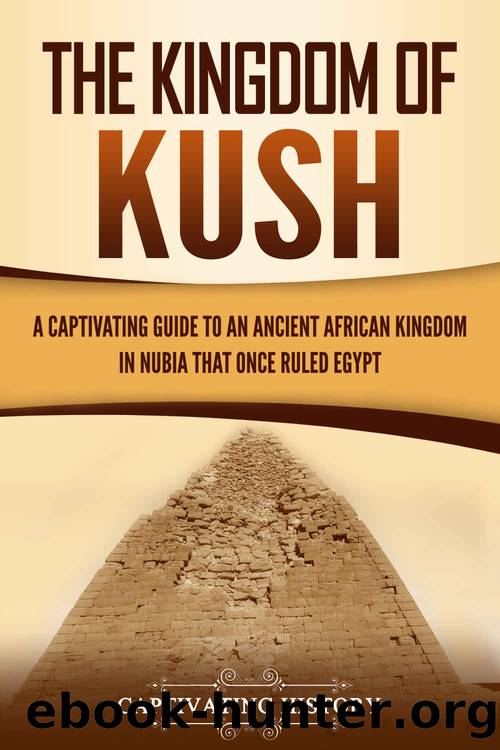The Kingdom of Kush: A Captivating Guide to an Ancient African Kingdom in Nubia That Once Ruled Egypt by Captivating History

Author:Captivating History [History, Captivating]
Language: eng
Format: azw3
Published: 2020-08-27T16:00:00+00:00
Chapter 5 – Kush between the 6th and 3rd Centuries
The next 150 years after the Nubian campaign lacks archaeological and textual evidence. It creates the illusion of a sudden decline, as nothing is preserved about the ten rulers who followed Aspelta except for their tombs. Even these were constantly plundered, so very little was found that gives an insight into the Kushite-Egyptian relationship. All ten kings, from Aramatelqo to Talakhamani, were buried in the Nuri necropolis near Napata, even though the capital was moved to Meroe. This means the tradition was followed, and the continuity of the politics from the Twenty-Fifth Dynasty onward was preserved. It seems even the succession line was straight, and all the kings belonged to the same royal family.
On average, each of the kings of the 6th and the beginning of the 5th century ruled for fifteen years. The titles these Kushite kings used were the same as all the other descendants of the Twenty-Fifth Dynasty, but the lack of Horus, Nebty, and Golden Horus among the titles is evident. It remains unknown if the lack of these titles was an effort of distancing Kush from the Egyptian-style of kingship, or they are missing simply because the sands of time destroyed the inscriptions of the royal tombs.
During this period, Meroe became an important economic, social, and cultural center of the Kingdom of Kush. The excessive building projects started with King Amaninatakilebte, who ruled in the late 6th century, and it continued through the reigns of his successors, Karkamani and Amaniastbarqo. They all invested in the Amun temple in Meroe. Napata wasn’t yet fully abandoned, so the building projects continued there as well, although they were limited to the extension of already existing temples.
During the mid-5th century, the ancient Greek historian Herodotus described the lands of Kush, naming them Aethiopia. But he wasn’t the first man to use this term. It was mentioned in Homer’s Iliad and Odyssey as the lands inhabited by the “burned-faced” people. The word Aethiopia itself is a derivative of two Greek words, which can be translated as “burned-face,” alluding to the skin color of the people who inhabited certain parts of Africa. But Herodotus was the first to use this term in relation to the Kingdom of Kush. He claimed that he personally traveled to Elephantine, the southernmost Egyptian city that was almost on the border with Aethiopia. According to Herodotus, there were two Aethiopias, one that extended from Elephantine to Meroe and the Utopian Aethiopia farther in the south.
Herodotus explains this Utopian Aethiopia in the far south produced enormous amounts of gold and imported huge elephants into Egypt. He describes the people of this faraway part of Kush as very tall and handsome, and he claims they lived very long. The existence of two Aethiopias can be explained by the fluid frontier of Kush and Egypt. It is possible the various political conflicts of the 5th century moved the border between the two kingdoms, meaning the territory in the north of Kush was often swapped with Egypt.
Download
This site does not store any files on its server. We only index and link to content provided by other sites. Please contact the content providers to delete copyright contents if any and email us, we'll remove relevant links or contents immediately.
| Africa | Americas |
| Arctic & Antarctica | Asia |
| Australia & Oceania | Europe |
| Middle East | Russia |
| United States | World |
| Ancient Civilizations | Military |
| Historical Study & Educational Resources |
The Battle of Mogadishu by Matt Eversmann & Dan Schilling(723)
The Confidence Men by Margalit Fox(671)
A History of the Muslim World since 1260: The Making of a Global Community by Vernon O. Egger(641)
The Spymaster of Baghdad by Margaret Coker(641)
Jack the Ripper and the East End by Peter Ackroyd(609)
Empire of Fear: Inside the Islamic State by Andrew Hosken(586)
The Afghanistan File by Prince Turki AlFaisal Al Saud(586)
The Crimean War by Winfried Baumgart(579)
Islam At The Gates: How Christendom Defeated the Ottoman Turks by Diane Moczar(573)
The Jerusalem Diamond by Noah Gordon(567)
Akhenaten by Dominic Montserrat(565)
A Concise History of Greece (Cambridge Concise Histories) by Richard Clogg(554)
Beirut 2020 by Charif Majdalani(554)
The History of Jihad by Robert Spencer(549)
Enemy in the East by Rolf-Dieter Müller(533)
Israel: Ancient Kingdom or Late Invention? by Daniel I. Block(532)
The Privatization of Israeli Security by Shir Hever(527)
The Nine Lives of Pakistan by Declan WALSH(521)
Destroying a Nation: The Civil War in Syria by Nikolaos van Dam(516)
